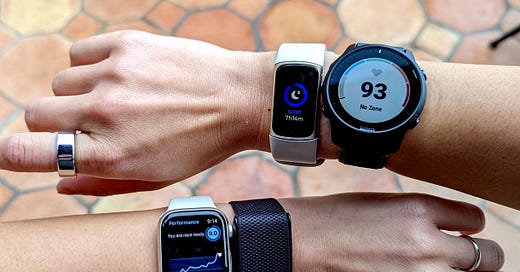Wearables Wednesday: Data, data, data
Validity, UX, and... data. The final big consideration when choosing a wearable, including the questions you need to ask a wearable company before you spend your wearable budget.
A few colleagues have recently asked me for my recommendations for which wearable they should use in research. My answer is always an underwhelming “it depends.”
Of course, it depends on your research questions and outcomes, and whether the features of the wearable match your distinct needs—including whether those features have been validated. Of course, it also depends on the UX of the platform. (A wearable can be the most valid data, but if it’s clunky, breaks, can’t hold a charge, and overall makes people pissed off to wear it, it’s not going to be a successful study.)
Something that we often fail to consider until it’s too late is the specifics of the data. Yes, it sounds boring. Bear with me.
Some companies (e.g., BIOSTRAP) specialize in working with researchers, and it shows in the flexibility of the data they can collect and how they can provide the data back to the researcher.
But most of the time, wearable companies involved in research are actually consumer-focused with a part of their business devoted to research partnerships. Because they try to make their wearable experience largely the same for everyone, their data collection processes may be harder to modify. And some companies won’t let you modify their sampling rate at all.
Here are some questions you should ask yourself and the company/companies with which you are considering working:
Does the sampling interval match what is needed for your research question(s)?
Example: Say you want to look at heart rate (HR) during exercise and nocturnal heart rate variability (HRV), and you’re considering using Apple Watches for the study. The Apple Watch does provide a relatively accurate heart rate—its accuracy outperforms many other wearables in terms of accurate heart rate measurement during exercise, especially for activities like resistance training (Støve and Hansen, 2022. So, the Apple Watch may be a great option for assessing heart rate during exercise or other activities that can be assessed with the exercise function.
However, its HR and HRV sampling rate differs depending on the activity. The automatic sampling intervals for HRV overnight are about once an hour, with seemingly random samplings. So, unless the HRV sampling intervals aren’t modified prior to the study (which can be done in some cases), it may collect the data during relatively random sleep stages, which would result in wildly different HRV scores and impractical information when averaged for a nightly HRV score. Conversely, the Oura ring assesses HRV every five minutes throughout the night. So, the Oura ring would win over the Apple Watch or nocturnal HRV, unless you know the typical sampling intervals upfront and plan to change the sampling interval prior to the study beginning.
What data will you receive and how will you receive the data? This is particularly important to ask upfront if you are using the company’s app.
What indices will you receive from the company, and which will you compute? Do you know enough about their algorithms to understand how their indices may be similar to or different from other ways of computing?
Do you need raw, unfiltered data (e.g., every HRV data point throughout each night) or is summarized data sufficient (e.g., average HRV score for each night)?
If you need raw, unfiltered data, will the company provide that to you? And do you have the analytic capabilities to work with unfiltered data?
If receiving summarized data, how are the summary scores calculated? And are they adequate for answering your research question?
Since missing data and identifying non-wear time as well as erroneous data points are important considerations, will the company clean data for you, or are you responsible for data cleaning and compensating for missing data?
As a general rule, you need to have a rationale for the decisions you’ve made about what data you’ll use and how it’s collected, as well as the code and/or tools used to calculate scores. Remember that whenever possible, this information should be included in any scientific communications about study findings to enable reproducibility and help promote open science.
I hope this helps not only my fellow researchers in deciding on a wearable—and I’m sure I’ve given you plenty of questions to ask—but also wearable companies in knowing what information is useful for researchers to know upfront.
Long story short: Please provide us with as much information as possible!
👋 I'm Lydia Roos, health psychologist and Founder of EvolveWell Research Partners.
📌 EvolveWell offers comprehensive research services for health, wellness, and fitness companies. [evolvewellresearch.com]
📩 Get in touch via email or LinkedIn.



